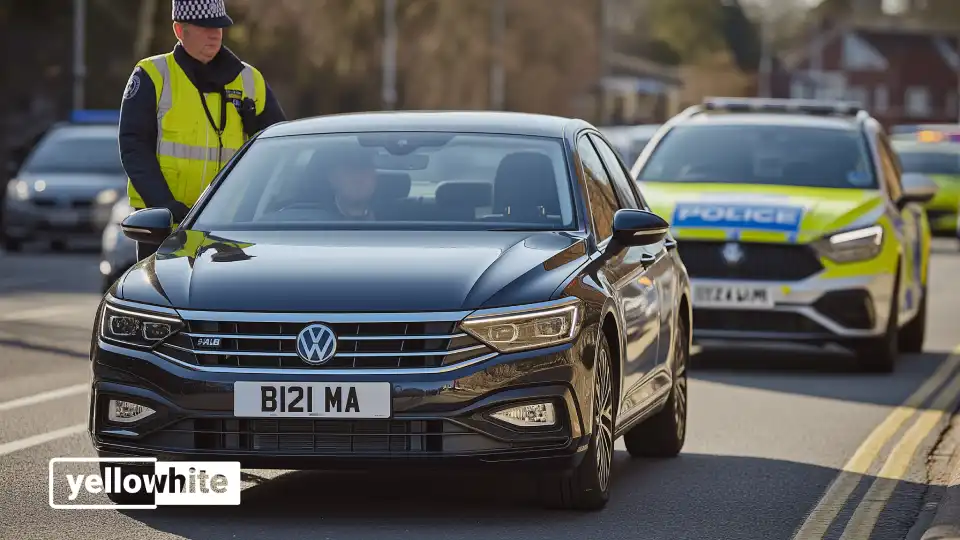Customising your car’s look with personalised number plates is more popular than ever. We get it, there’s something deeply satisfying about a plate that matches your name, your business, or just your sense of style. But while personalisation is fun, there’s a fine line between stylish and illegal.
At Yellowhite, we speak to hundreds of customers who want their plate to pop but without the panic of fines or MOT failures. And here’s the good news: it’s absolutely possible to have bold, beautiful plates that are 100% road-legal. You just need to understand the rules. So whether you’re considering tinted finishes, ghost plates or anything in-between, this post will help you stay on the right side of the law… and the roadside cameras.
Shop our full range of private plates → private plates
What number plates are illegal in the UK?
To keep things clear and consistent across all UK vehicles, the DVLA enforces strict guidelines under British Standard BS AU 145e. These regulations are not just box-ticking bureaucracy, they exist to ensure every vehicle can be clearly identified in daylight, darkness and by ANPR cameras.
The legal basics:
All number plates must have:
- Font: Only the standard ‘Charles Wright’ typeface is allowed—no swirly scripts or quirky alternates.
- Character size: Each number or letter must be 79mm tall and 50mm wide (except ‘1’ and ‘I’), with a 14mm stroke thickness.
- Spacing: There must be 11mm between characters, 33mm between the groups, and margins around the edges.
- Colours: White on the front, yellow on the back. Both must be reflective and clear.
- Supplier’s info: A legal plate includes the maker’s name and postcode printed at the bottom.
These rules might sound like small details, but they make a big difference. For example, plates with mis-spaced characters (like trying to make “BOSS” out of “B055”) can be hard to read and are technically illegal. Likewise, using decorative backgrounds or alternate colours might look cool to some, but they’ll land you in hot water during your next MOT.
Plates become illegal if they deviate from these rules. Common examples include:
- Mis‑spaced characters: Letters or numbers too close or too far apart.
- Custom fonts: Any style other than ‘Charles Wright’, including script or novelty typefaces.
- Decorative backgrounds: Logos, graphics, or coloured stripes behind characters.
- Tinted or shaded surfaces: Anything that reduces reflectivity or legibility.
Are Tinted, 3D, or Ghost Number Plates Illegal?
The short answer? It depends. Let’s break it down with some clarity.
Are tinted number plates illegal in the UK?
Yes, absolutely. Tinted plates, or plates with a smoked or shaded overlay, might look slick, but they reduce reflectivity and visibility, which are both legal requirements. Even a light tint can cause problems with ANPR cameras or police visibility checks. If it’s not bright and reflective, it’s not road-legal.
Are 3D or 4D number plates illegal in the UK?
No, they’re perfectly legal—as long as they stick to DVLA specs. 4D plates typically use a slightly raised gel to give depth and shine. The key is compliance: they must use the correct ‘Charles Wright’ font, be reflective, and adhere to all size and spacing rules. If you’re ordering your 3D plates from Yellowhite, you’re covered.
Are ghost number plates illegal in the UK?
Yes. There’s no grey area here—ghost number plates are illegal in the UK. These plates use subtle, low-contrast designs that may look futuristic but are unreadable to ANPR systems, enforcement cameras, and emergency responders. That defeats the entire purpose of number plates: clear, instant vehicle identification.
Ghost plates are not approved under BS AU 145e and fail to meet legal requirements for contrast and reflectivity. They’ve been linked in the media to attempts to evade law enforcement, and using them can result in serious legal consequences.
Want to learn more? Check out our full article on Ghost Number Plates.
What are the penalties for illegal number plates?
Fitting or using illegal plates can lead to:
- Fixed penalty fines: Up to £1,000 for non‑compliant plates.
- MOT failure: Any illegible or non‑standard plate will cause an automatic fail at test.
- Points on licence: In serious cases, courts can award penalty points.
- Vehicle seizure: Persistent offenders risk having plates or vehicles impounded.
The worst part? Most of these issues are easily avoidable. A properly made, compliant plate doesn’t cost more than a dodgy one and gives you total peace of mind.
How to make sure your number plates are legal
If you’re not sure whether your plates are legal, here’s a simple checklist:
- Buy from an authorised supplier: Yellowhite is a DVLA-certified provider, and every private plate we make meets BS AU 145e.
- Stick to the font: The Charles Wright typeface isn’t optional. It’s the only font allowed by law.
- Mind the layout: Check for the correct size, spacing, and placement of characters.
- No fancy overlays: Avoid any tinting, logos, or patterns in the background.
- Keep your receipts: Always keep proof of purchase and compliance, it might just save you hassle at your next MOT.
Want a standout look without skirting the law? Explore our fully compliant, premium options like 4D Number Plates that combine style with full DVLA compliance.
In the world of private plates, there’s a difference between standing out… and standing in court. Illegal number plates can lead to costly fines and wasted time, but with a little guidance and the right supplier, you can enjoy a standout design that’s still 100% above board.
Yellowhite’s mission is simple: bold, beautiful, road-legal plates that you can be proud of. No hassle. No hidden risks. Just proper plates, properly done.

